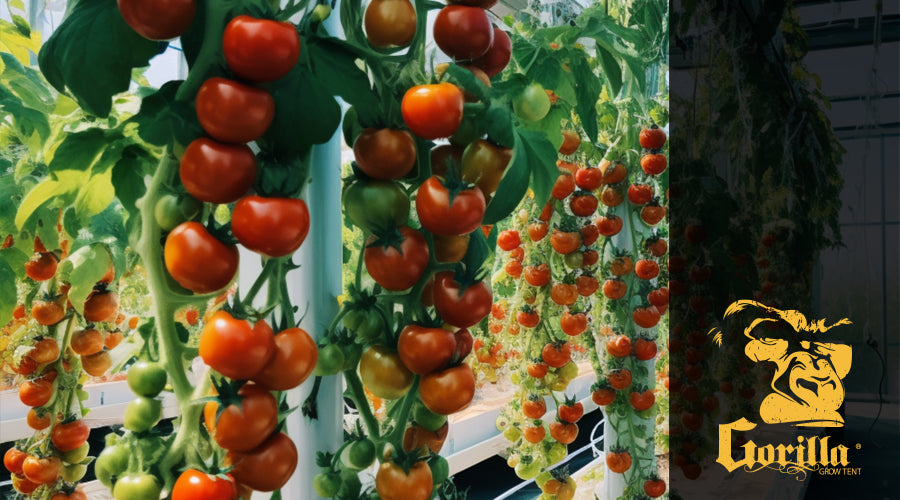
Inline Duct Fans for Optimal Grow Tent Ventilation

In the realm of indoor horticulture, maintaining an optimal environment for your plants is crucial for their successful growth and flourishing. Among the essential elements that play a pivotal role in this endeavor is ventilation. Inline duct fans emerge as indispensable players in this arena, offering a plethora of benefits that contribute to the well-being of your indoor garden.
What are Inline Duct Fans?
Inline duct fans, also known as centrifugal fans or inline duct boosters, are specialized ventilation systems designed to seamlessly integrate into ductwork, enabling them to efficiently circulate air through extensive duct systems. Their unique design features a fan blade assembly enclosed within a housing, which allows for the creation of powerful airflow with minimal noise.
Why Inline Duct Fans are Essential for Grow Tents
Inline duct fans are the cornerstone of effective ventilation in grow tents, offering a multitude of benefits that foster a healthy and productive environment for your plants:
Enhanced Ventilation:
Inline duct fans effectively combat the accumulation of stale air, a common pitfall in enclosed grow tent environments. By continuously exchanging stagnant air with fresh, CO2-rich air, these fans stimulate healthy plant growth and development, ensuring they receive the vital oxygen they need to thrive.
Humidity Control:
Excessive humidity poses a significant threat to plants, fostering the proliferation of mold and mildew, which can lead to plant damage and diseases. Inline duct fans excel at regulating humidity levels by expelling moisture-laden air, preventing the onset of harmful fungal growth, and maintaining a healthy microclimate for your plants.
Temperature Regulation:
Maintaining optimal temperature conditions is paramount for plant health, as different plant species have specific temperature ranges within which they flourish. Inline duct fans can be employed to modulate temperature fluctuations, ensuring that your plants thrive within their ideal temperature range, whether you're cultivating heat-loving peppers or delicate ferns.
Noise Reduction:
Unlike traditional fans, inline duct fans operate with remarkable quietness, ensuring undisturbed tranquility for both you and your neighbors. Their unobtrusive nature allows for seamless integration into any indoor growing space, whether it's a dedicated grow room or a spare corner in your home.
Choosing the Right Inline Duct Fan for Your Grow Tent
To maximize the benefits of inline duct fans and ensure optimal ventilation for your grow tent, it is essential to select the most appropriate model for your specific needs. Consider these key factors when making your choice:
Grow Tent Size:
The size of your grow tent dictates the CFM (Cubic Feet per Minute) rating required for effective ventilation. Larger grow tents demand fans with higher CFM ratings to ensure adequate air circulation and prevent CO2 buildup.
Plant Requirements:
Different plant species exhibit varying ventilation needs. If your grow tent houses plants with high ventilation demands, such as tomatoes or cucumbers, opt for a fan with a correspondingly high CFM rating to accommodate their increased oxygen requirements.
Budgetary Considerations:
Inline duct fans range in price from around $50 to $200. Choose a fan that aligns with your budget while meeting your ventilation requirements. Consider the long-term investment in the health and productivity of your plants when making your decision.
Installing and Operating Your Inline Duct Fan for Optimal Performance
To harness the full potential of your inline duct fan and ensure it functions effectively within your grow tent, follow these installation and operation guidelines:
Proper Sizing:
Ensure the chosen fan is appropriately sized for your grow tent. An oversized fan can create excessive airflow, potentially damaging delicate plants or causing temperature fluctuations. An undersized fan, on the other hand, may struggle to maintain optimal ventilation, leading to CO2 buildup and humidity issues.
Strategic Placement:
Install the fan in a location that allows for unobstructed airflow. Avoid placing it near plants or obstructions that could hinder air circulation. A common practice is to mount the fan at the top of the grow tent, allowing for efficient air exchange throughout the enclosed space.
Ducting Selection:
Use ducting that is compatible with the size of your fan and the layout of your grow tent. Properly secure the ducting to prevent leaks and ensure seamless airflow. Consider using flexible ducting for easy installation and maneuverability.
Regular Maintenance:
Regularly inspect the fan blades for debris and clean them as needed to maintain optimal performance. Excessive dust and dirt accumulation can impede airflow and reduce the fan's efficiency.
Tips for Optimizing Grow Tent Ventilation
- Choose the right inline duct fan. The size of your grow tent will determine the CFM (cubic feet per minute) rating of the fan you need. A larger grow tent will require a fan with a higher CFM rating.
- Install the fan correctly. The fan should be installed at the top of your grow tent, away from any plants or obstructions. Be sure to properly secure the ducting to prevent leaks.
- Use carbon filters to remove odors. Carbon filters will help to remove odors from your grow tent, which can be helpful for both you and your neighbors.
- Monitor temperature and humidity levels. The ideal temperature for most plants is between 70 and 85 degrees Fahrenheit. The ideal humidity level for most plants is between 40 and 60 percent.
- Use a fan controller to adjust airflow. A fan controller will allow you to adjust the speed of your fan, which can be helpful for controlling temperature and humidity levels.
- Make sure your grow tent is getting enough fresh air. You should have at least one intake fan and one exhaust fan in your grow tent. The intake fan should be located at the bottom of the tent, and the exhaust fan should be located at the top of the tent.
- Clean your fans and ducting regularly. Dust and debris can build up in your fans and ducting, which can reduce airflow. Be sure to clean them regularly to keep them working properly.
- Use a dehumidifier if necessary. If the humidity level in your grow tent is too high, you can use a dehumidifier to help lower it.
- Be careful not to over-ventilate your grow tent. Too much airflow can dry out your plants.
- Consult with an expert if you have any questions. There are many experienced growers who can offer you advice on how to optimize ventilation in your grow tent.
Cultivating Success with Inline Duct Fans
Inline duct fans emerge as indispensable tools for cultivating a thriving indoor garden. By effectively ventilating your grow tent, these versatile systems promote healthy plant growth, combat humidity issues, regulate temperature, and minimize noise disturbances. By selecting the right fan, installing it meticulously, and conducting regular maintenance, you can harness the power of inline duct fans to create an optimal environment for your cherished plants to flourish.
Embark on your indoor gardening journey with confidence, knowing that your plants have the ideal environment to thrive under the watchful care of inline duct fans.


